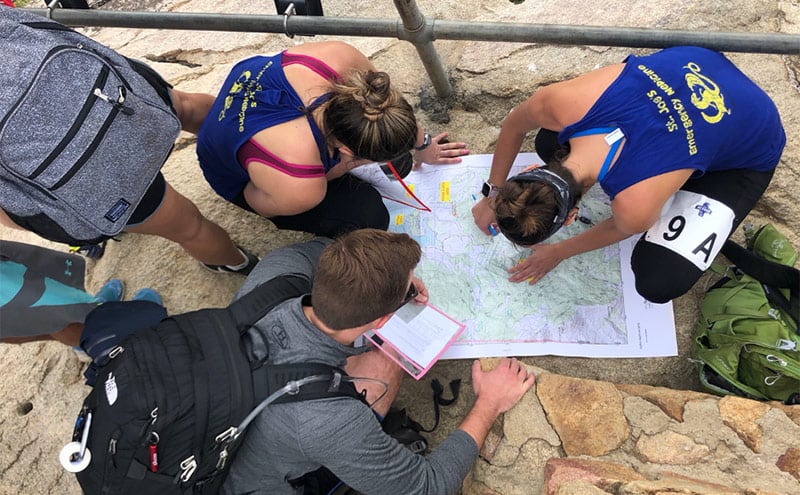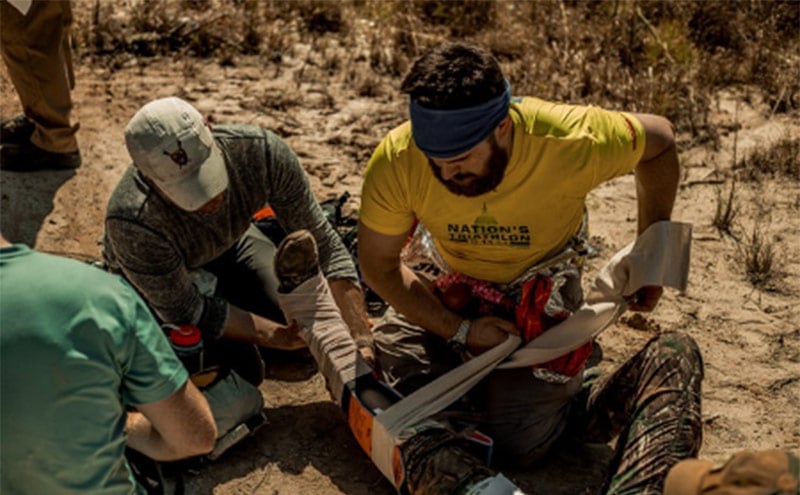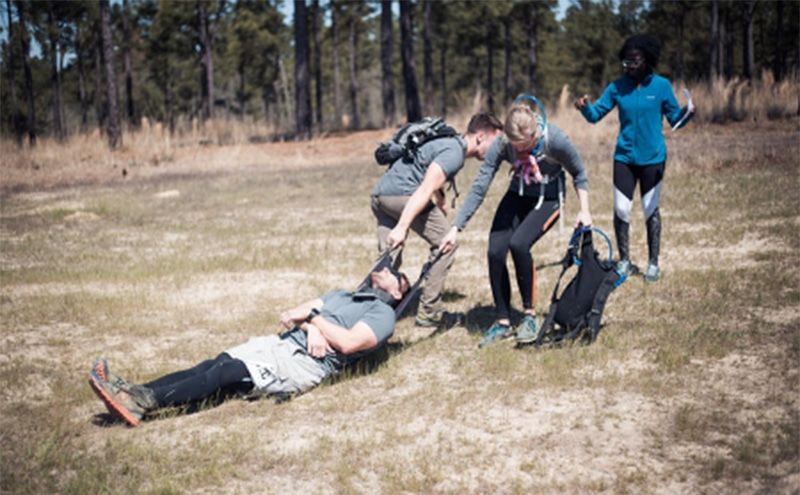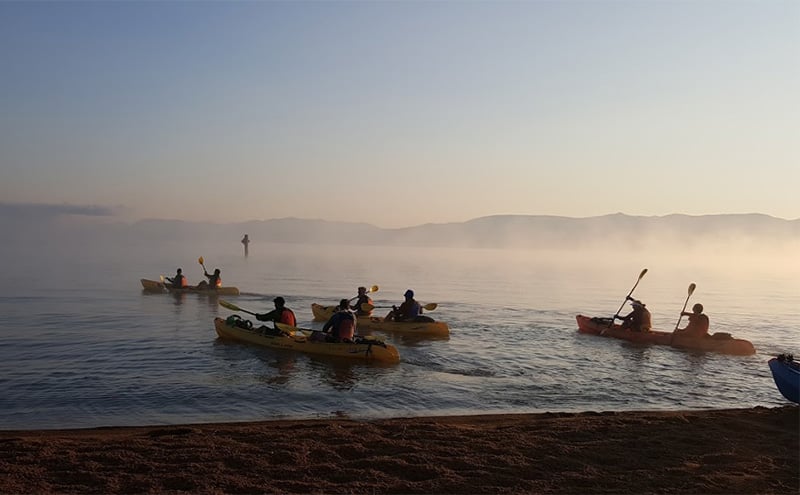
20 Years of MedWAR
Simulated training has found a foothold in the core principles of medical education in this country. Likewise, the community of adventure racing has grown exponentially. MedWAR (Medical Wilderness Adventure Race) was conceived twenty years ago as a marriage between the two concepts and has expanded all over North America, including races in conjunction with larger professional medical society meetings. MedWAR attracts racers, volunteers, and facilitators from a wide array of backgrounds and experience unified by a passion for wilderness medicine and education.
WHO – THE FOUNDERS
Adventure races have become a global phenomenon in the late 1990’s and early 2000’s. This new format of competition and endurance were further popularized in international television programming with The Amazing Race and Eco-Challenge: The Expedition Race. Many smaller scale adventure races developed following this surge including a race in 2000 that served as the inspiration for David Ledrick and Michael Caudell to create a MedWAR - a fusion between an adventure race and wilderness medicine challenges. Caudell recalls his early interest for wilderness medicine developing as it does for many of us: a passion for the outdoors growing up and a desire to translate his medical training to an austere environment.
As faculty at the Medical College of Georgia (MCG), Caudell and Ledrick teamed up with a group of MCG medical students to develop MedWAR as a research project since there was nothing else around like it in formal medical training. The first MedWAR race was a success with participants from four countries including Australia and Canada. Ledrick moved to Ohio in 2002 and established the Midwest MedWAR with faculty support from Mike Omori. The students at MCG have continued the Southeast MedWAR with Caudell’s oversight and faculty support from Hartmut Gross and, in recent years, Taylor Haston who has also served as oversight faculty with Caudell for the newer EMRA races.
As more racers and volunteers participated in MedWAR events, greater interest developed to expand the race series. With Ledrick and Caudell in separate regions, the duo agreed on the need to develop a foundation to maintain the quality and integrity of the MedWAR curriculum early to support the demand for expansion races. The following year they created the non-profit North American Educational Racing (NAEAR), formalized the curriculum and mission, and trademarked “MedWAR.” A few years later, Hillary Irons joined NAEAR as Expansion Director to support the continued growth and development of new races.
Irons, Caudell, and Ledrick support every sanctioned MedWAR challenge with Irons as the go-to for race development and coordination between NAEAR and the race directors. All three review scenarios and race course content to ensure adherence to the MedWAR curriculum and standards and occasionally travel to expansion races to lend a hand on race day.
WHO – RACE DIRECTORS, VOLUNTEERS, AND RACERS
Each race is unique in the makeup of its participants as well as leadership. Although the early races were directed toward medical trainees, the MedWAR standard is that each race is inclusive to anyone with an interest in wilderness medicine. There remains no minimum educational requirement for racers or volunteers, just a passion and willingness to learn with guidance and time to prepare ahead of race day. In addition to the practicing providers and medical trainees, MedWAR racers often include military personnel and first responders. Laypersons are welcome, such as a father-son duo who participated to learn essential survival skills as the two frequently recreated in the wilderness, and to reinforce the critical thinking and ingenuity that is required in managing injuries and emergencies in an austere environment.
Race leadership typically includes medical faculty, privately practicing physicians, wilderness medicine fellows, residents, medical students, or some combination thereof. Most race directors were former MedWAR volunteers or and wanted to bring the event to their home. Recently MedWAR has expanded even further to include conference-associated races sponsored by professional medical organizations including the Emergency Medicine Residents Association (EMRA) in 2016 and the Society of Academic Emergency Medicine (SAEM) and Wilderness Medical Society (WMS) in 2019. Some races are directed by independent healthcare entities, such as Barton Health that has produced a MedWAR Challenge in South Lake Tahoe each of the past four years. Recently expansion races have also been produced by educational non-profits focused on wilderness medical education, including the Northwest MedWAR introduced last year by Pacific Northwest Wilderness Medicine (PNWM).
Volunteers for the races are critical in staffing the stations as well as supporting the general operations of the race. Many individuals volunteer as mock patients to refresh and enhance their own wilderness skills and may come from the community at large including local rescue, EMS, military, and outdoor recreationalists. MedWAR races also tend to receive influxes of medical student volunteers from nearby schools. For many, this is their introduction to wilderness medicine.
WHAT
Auerbach’s Wilderness Medicine textbook and MedWAR Challenge’s website provide thorough outlines of the MedWAR format and curriculum. NAEAR established this comprehensive curriculum to draw on basic wilderness medicine principles and skills with some occasional advanced application balanced against navigation and survival. General guidance and race format is provided by the race directors prior to race day with ample time for the racers to gather the appropriate gear and review relevant material. Appropriate expectations are crucial to the enjoyment of the race.

Each race has its own flavor. Some take on an overarching theme, and others will have various mock settings for each of their stations such as an avalanche, high altitude, desert, etc. Multisport races are incredibly rewarding but the increased insurance and rental costs are a deterrent to smaller races, thus the larger races more often incorporate mountain biking, canoeing, kayaking, and or skiing legs. Some races, such as the Mid-Atlantic, are structured as a two-courses-in-one to cater to varying athletic capabilities which requires more coordination but expands attendance.
WHEN & WHERE
The complete MedWAR series is spread out over the United States and Canada clustered predominantly in the shoulder seasons. Many races have come and gone, but the Southeast, Midwest, and Mid-Atlantic challenges have endured since their inception. Each year sees new additions with the hope that they will continue as well, and occasionally races come out of retirement such as the AZ MedWAR which returned this January with a winter desert challenge.
WHY
While the race series has expanded over the last two decades, MedWAR’s mission remained unchanged. Each group of race directors brings something new to the event, and central themes have emerged through the research around and evolution of MedWAR; innovation & improvisation, stress inoculation, team dynamics, and interdisciplinary development.

Innovation and improvisation are challenged throughout the preparation, organization, production, and participation in each MedWAR. Not only are racers challenged to utilize these skills during the course, but race directors are consistently pushed to adapt and create new solutions throughout the process. The event was born out of innovation and has been reused several times over as a platform to develop and study methods of standardized performance evaluation and high-fidelity low-cost simulation techniques.
MedWAR directors are also challenged to adapt to changing conditions. Races have been entirely threatened by venue demands and weather notably in the early spring or late fall months. For instance, this past October the EMRA MedWAR survived a snowstorm when organizers were forced to move the race at the last minute. Instead they hosted a successful indoor competition with a single outdoor leg that featured a blindfolded tent challenge completed by all 12 teams.
Another theme that has emerged is the value of stress inoculation in training. Performing tasks in a competitive environment with a time challenge places stress on the racers which makes itself evident even with seasoned providers. The physical environment adds its own stressors, be it a thick swamp, inclement weather, or the sheer magnitude of the course. Team dynamics are also tested under this stress with the opportunity to develop tactics to become stronger as a unit.

Finally, MedWAR races support interdisciplinary development. Organizers cultivate community partnerships with other medical disciplines, local organizations, sponsors, and parks, and race day provides the staging for joint trainings. Just like wilderness medicine, MedWAR is not bound to any particular medical specialty; anyone who wants to do this can do it. And just like medicine, collaboration is key.
THE FUTURE OF MEDWAR
MedWAR continues to expand to carry on its mission because it’s a gratifying, low cost, high quality educational event. Over the last year NAEAR received six applications from students, nurses, and practicing physicians for new expansion races. The fall-winter lineup is in development (pending on the progress of the global pandemic) with discussion of new races which will be added to the series as they are confirmed.
Applying as a MedWAR race director is simple (visit the link below) but organizing the race is not easy. Time, infrastructure, and faculty support are fundamental, however if the latter are missing NAEAR is always available to help mitigate if the directors are determined. MedWAR will continue each year with newer and better races, and looks forward to another wonderful 20 years as the field of wilderness medicine itself continues to evolve. While the participation in MedWAR is incredibly diverse, the unifying factor is a passion for quality wilderness medical education and an appreciation for fun. In Michael Caudell’s words, “people seem to like it.”
For more information and to contact MedWAR, visit their website.
Cassie Lowry Edmark, DO



